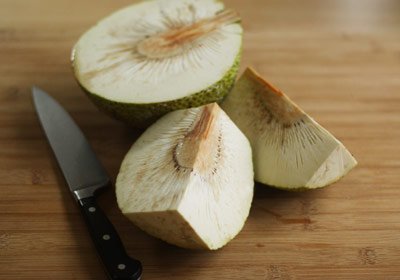Story by Shannon Wianecki
 Standing beneath the breadfruit trees, we watch the rain rush in from the sea, as it does here in East Maui. A curtain of mist advances; then we hear the soft roar as the first fat drops strike our faces. Ducking deeper under the tree canopy, we’re able to stay almost dry. The same interlocking leaves that provide shade at midday act as an umbrella during cloudbursts.
Standing beneath the breadfruit trees, we watch the rain rush in from the sea, as it does here in East Maui. A curtain of mist advances; then we hear the soft roar as the first fat drops strike our faces. Ducking deeper under the tree canopy, we’re able to stay almost dry. The same interlocking leaves that provide shade at midday act as an umbrella during cloudbursts.
I’m at Kahanu Garden with Ian Cole, one of three employees of the National Tropical Botanical Garden’s Breadfruit Institute. We’re sheltered under the elegant, sixty-foot-tall trees that stand at the base of Pi‘ilanihale, the largest heiau (temple) in Hawai‘i. This mind-bending, three-acre archeological site dates back to the fourteenth century; its attending orchard is just as ancient. These particular breadfruit trees are the grandchildren of those planted to feed bygone kings and queens. After hundreds of years, this pre-Contact grove is still producing food. If only we remembered how to eat it.
Breadfruit is still beloved in Samoa and Tonga, where it’s salted and steamed or mashed with coconut. But here in Hawai‘i, the nutrient-packed Polynesian staple has fallen so far out of fashion it’s hard to find. Grocery stores don’t carry it. It’s a special-order item from distributors like Kula Produce. People with backyard breadfruit trees fret over the bright green, smallish volleyballs rotting on their lawn. Little do they know that they’re sitting on a resource that could very well feed the world. Luckily, several dedicated people are working to restore breadfruit to its rightful place, both on the plate and in the culture.
The rain lets up and Cole shows me around. The sandy-haired Florida transplant is easygoing enough to acclimate to sleepy Hana, but his ample energy is focused on a single goal: to get more people growing and eating breadfruit. Aside from the massive heiau, Kahanu Garden is home to the largest breadfruit collection in the world, which Cole manages: over 120 varieties from thirty-one Pacific islands. This living museum is the vision of one woman, Cole’s boss, Diane Ragone. Back in the 1980s, she island-hopped across Oceania to personally collect breadfruit samples, each one bearing unique characteristics. The Marquesas offered the intrepid botanist fifty-five varieties. Tahiti gave her dozens. Hawai‘i has only ever had just one: ‘ulu.





